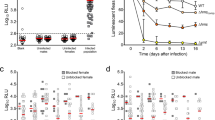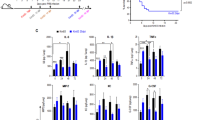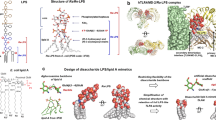Abstract
At mammalian body temperature, the plague bacillus Yersinia pestis synthesizes lipopolysaccharide (LPS)–lipid A with poor Toll-like receptor 4 (TLR4)–stimulating activity. To address the effect of weak TLR4 stimulation on virulence, we modified Y. pestis to produce a potent TLR4-stimulating LPS. Modified Y. pestis was completely avirulent after subcutaneous infection even at high challenge doses. Resistance to disease required TLR4, the adaptor protein MyD88 and coreceptor MD-2 and was considerably enhanced by CD14 and the adaptor Mal. Both innate and adaptive responses were required for sterilizing immunity against the modified strain, and convalescent mice were protected from both subcutaneous and respiratory challenge with wild-type Y. pestis. Despite the presence of other established immune evasion mechanisms, the modified Y. pestis was unable to cause systemic disease, demonstrating that the ability to evade the LPS-induced inflammatory response is critical for Y. pestis virulence. Evading TLR4 activation by lipid A alteration may contribute to the virulence of various Gram-negative bacteria.
This is a preview of subscription content, access via your institution
Access options
Subscribe to this journal
Receive 12 print issues and online access
$259.00 per year
only $21.58 per issue
Buy this article
- Purchase on SpringerLink
- Instant access to full article PDF
Prices may be subject to local taxes which are calculated during checkout






Similar content being viewed by others
References
Perry, R.D. & Fetherston, J.D. Yersinia pestis–etiologic agent of plague. Clin. Microbiol. Rev. 10, 35–66 (1997).
Sodeinde, O.A. et al. A surface protease and the invasive character of plague. Science 258, 1004–1007 (1992).
Nakajima, R., Motin, V.L. & Brubaker, R.R. Suppression of cytokines in mice by protein A-V antigen fusion peptide and restoration of synthesis by active immunization. Infect. Immun. 63, 3021–3029 (1995).
Cornelis, G.R. The Yersinia Ysc-Yop 'type III' weaponry. Nat. Rev. Mol. Cell Biol. 3, 742–752 (2002).
Akira, S. & Takeda, K. Toll-like receptor signalling. Nat. Rev. Immunol. 4, 499–511 (2004).
Liew, F.Y., Xu, D., Brint, E.K. & O'Neill, L.A. Negative regulation of Toll-like receptor-mediated immune responses. Nat. Rev. Immunol. 5, 446–458 (2005).
Hoshino, K. et al. Cutting edge: Toll-like receptor 4 (TLR4)-deficient mice are hyporesponsive to lipopolysaccharide: evidence for TLR4 as the Lps gene product. J. Immunol. 162, 3749–3752 (1999).
Lien, E. et al. Toll-like receptor 4 imparts ligand-specific recognition of bacterial lipopolysaccharide. J. Clin. Invest. 105, 497–504 (2000).
Poltorak, A. et al. Defective LPS signaling in C3H/HeJ and C57BL/10ScCr mice: mutations in Tlr4 gene. Science 282, 2085–2088 (1998).
Raetz, C.R.H. & Whitfield, C. Lipopolysaccharide endotoxins. Annu. Rev. Biochem. 71, 635–700 (2002).
Shimazu, R. et al. MD-2, a molecule that confers lipopolysaccharide responsiveness on Toll-like receptor 4. J. Exp. Med. 189, 1777–1782 (1999).
Miyake, K. Innate recognition of lipopolysaccharide by Toll-like receptor 4-MD-2. Trends Microbiol. 12, 186–192 (2004).
Wright, S.D., Ramos, R.A., Tobias, P.S., Ulevitch, R.J. & Mathison, J.C. CD14, a receptor for complexes of lipopolysaccharide (LPS) and LPS binding protein. Science 249, 1431–1433 (1990).
Zähringer, U., Lindner, B. & Rietschel, E.T. in Endotoxin in Health and Disease (eds. Brade, H., Opal, S.M., Vogel, S.N. & Morrison, D.C.) 93–114 (Marcel Dekker, New York, 1999).
Dixon, D.R. & Darveau, R.P. Lipopolysaccharide heterogeneity: innate host responses to bacterial modification of lipid a structure. J. Dent. Res. 84, 584–595 (2005).
Kawahara, K., Tsukano, H., Watanabe, H., Lindner, B. & Matsuura, M. Modification of the structure and activity of lipid A in Yersinia pestis lipopolysaccharide by growth temperature. Infect. Immun. 70, 4092–4098 (2002).
Rebeil, R., Ernst, R.K., Gowen, B.B., Miller, S.I. & Hinnebusch, B.J. Variation in lipid A structure in the pathogenic yersiniae. Mol. Microbiol. 52, 1363–1373 (2004).
Knirel, Y.A. et al. Temperature-dependent variations and intraspecies diversity of the structure of the lipopolysaccharide of Yersinia pestis. Biochemistry 44, 1731–1743 (2005).
Loppnow, H. et al. IL-1 induction capacity of defined lipopolysaccharide partial structures. J. Immunol. 142, 3229–3238 (1989).
Golenbock, D.T., Hampton, R.Y., Qureshi, N., Takayama, K. & Raetz, C.R.H. Lipid A-like molecules that antagonize the effects of endotoxins on human monocytes. J. Biol. Chem. 266, 19490–19498 (1991).
Carty, S.M., Sreekumar, K.R. & Raetz, C.R.H. Effect of cold shock on lipid A biosynthesis in Escherichia coli. Induction at 12 degrees C of an acyltransferase specific for palmitoleoyl-acyl carrier protein. J. Biol. Chem. 274, 9677–9685 (1999).
Vorachek-Warren, M.K., Carty, S.M., Lin, S., Cotter, R.J. & Raetz, C.R.H. An Escherichia coli mutant lacking the cold shock-induced palmitoleoyltransferase of lipid A biosynthesis: absence of unsaturated acyl chains and antibiotic hypersensitivity at 12 degrees C. J. Biol. Chem. 277, 14186–14193 (2002).
Deng, W. et al. Genome sequence of Yersinia pestis KIM. J. Bacteriol. 184, 4601–4611 (2002).
Perry, R.D. et al. DNA sequencing and analysis of the low-Ca2+-response plasmid pCD1 of Yersinia pestis KIM5. Infect. Immun. 66, 4611–4623 (1998).
Parkhill, J. et al. Genome sequence of Yersinia pestis, the causative agent of plague. Nature 413, 523–527 (2001).
Akashi, S. et al. Human MD-2 confers on mouse Toll-like receptor 4 species-specific lipopolysaccharide recognition. Int. Immunol. 13, 1595–1599 (2001).
Hajjar, A.M., Ernst, R.K., Tsai, J.H., Wilson, C.B. & Miller, S.I. Human Toll-like receptor 4 recognizes host-specific LPS modifications. Nat. Immunol. 3, 354–359 (2002).
Poltorak, A., Ricciardi-Castagnoli, P., Citterio, S. & Beutler, B. Physical contact between lipopolysaccharide and Toll-like receptor 4 revealed by genetic complementation. Proc. Natl. Acad. Sci. USA 97, 2163–2167 (2000).
Schromm, A.B. et al. Molecular genetic analysis of an endotoxin nonresponder mutant Cell Line. A point mutation in a conserved region of MD-2 abolishes endotoxin-induced signaling. J. Exp. Med. 194, 79–88 (2001).
Nagai, Y. et al. Essential role of MD-2 in LPS responsiveness and TLR4 distribution. Nat. Immunol. 3, 667–672 (2002).
Skurnik, M. & Bengoechea, J.A. The biosynthesis and biological role of lipopolysaccharide O-antigens of pathogenic Yersiniae. Carbohydr. Res. 338, 2521–2529 (2003).
Vinogradov, E.V. et al. The core structure of the lipopolysaccharide from the causative agent of plague, Yersinia pestis. Carbohydr. Res. 337, 775–777 (2002).
Jiang, Z. et al. CD14 is required for MyD88-independent LPS signaling. Nat. Immunol. 6, 565–570 (2005).
Huber, M. et al. R-form LPS, the master key to the activation of TLR4/MD-2-positive cells. Eur. J. Immunol. 36, 701–711 (2006).
van Duin, D., Medzhitov, R. & Shaw, A.C. Triggering TLR signaling in vaccination. Trends Immunol. 27, 49–55 (2006).
Parent, M.A. et al. Cell-mediated protection against pulmonary Yersinia pestis infection. Infect. Immun. 73, 7304–7310 (2005).
Ulevitch, R.J. Therapeutics targeting the innate immune system. Nat. Rev. Immunol. 4, 512–520 (2004).
Agrawal, S. & Kandimalla, E.R. Modulation of Toll-like receptor 9 responses through synthetic immunostimulatory motifs of DNA. Ann. NY Acad. Sci. 1002, 30–42 (2003).
Goguen, J.D., Yother, J. & Straley, S.C. Genetic analysis of the low calcium response in Yersinia pestis mu d1(Ap lac) insertion mutants. J. Bacteriol. 160, 842–848 (1984).
Westphal, O., Luderitz, O. & Bister, F. Uber die extraktion von bacterien mit phenol/wasser. Z. Naturforsch. B 7, 148–155 (1952).
Hirschfeld, M., Ma, Y., Weis, J.H., Vogel, S.N. & Weis, J.J. Cutting edge: Repurification of lipopolysaccharide eliminates signaling through both human and murine Toll-like receptor 2. J. Immunol. 165, 618–622 (2000).
Liu, W-C., Oikawa, M., Fukase, K., Suda, Y. & Kusumoto, S. A divergent synthesis of lipid A and its chemically stable unnatural analogues. Bull. Chem. Soc. Jpn. 72, 1377–1385 (1999).
Latz, E. et al. Lipopolysaccharide rapidly traffics to and from the Golgi apparatus with the Toll-like receptor 4-MD-2–CD14 complex in a process that is distinct from the initiation of signal transduction. J. Biol. Chem. 277, 47834–47843 (2002).
Bandyopadhyay, S.K., Leonard, G.T., Jr, Bandyopadhyay, T., Stark, G.R. & Sen, G.C. Transcriptional induction by double-stranded RNA is mediated by interferon-stimulated response elements without activation of interferon-stimulated gene factor 3. J. Biol. Chem. 270, 19624–19629 (1995).
Yamamoto, M. et al. TRAM is specifically involved in the Toll-like receptor 4–mediated MyD88-independent signaling pathway. Nat. Immunol. 4, 1144–1150 (2003).
Yamamoto, M. et al. Role of adaptor TRIF in the MyD88-independent toll-like receptor signaling pathway. Science 301, 640–643 (2003).
Yamamoto, M. et al. Essential role for TIRAP in activation of the signalling cascade shared by TLR2 and TLR4. Nature 420, 324–329 (2002).
Takeuchi, O. et al. Differential roles of TLR2 and TLR4 in recognition of gram-negative and gram-positive bacterial cell wall components. Immunity 11, 443–451 (1999).
Adachi, O. et al. Targeted disruption of the MyD88 gene results in loss of IL-1- and IL-18-mediated function. Immunity 9, 143–150 (1998).
Moore, K.J. et al. Divergent response to LPS and bacteria in CD14-deficient murine macrophages. J. Immunol. 165, 4272–4280 (2000).
Acknowledgements
We thank A. Yuan, N. Pan and K. Trimble for help with experiments; N. Deitemeyer and C. Lee for technical assistance; A. Cerny and J. Boulangier for animal husbandry; D.T. Golenbock for support; and R.R. Ingalls, N. Silverman and K. Fitzgerald for critically reading the manuscript. Supported by the National Institute of Allergy and Infectious Diseases of the National Institutes of Health (R01 AI057588 to E.L.) and the Diabetes Endocrinology Research Center (DK 32520).
Author information
Authors and Affiliations
Corresponding author
Ethics declarations
Competing interests
A patent has been filed concerning the use of modified bacterial strains as vaccines.
Supplementary information
Supplementary Fig. 1
Y. pestis grown at 37 °C is a poor stimulator of TLR4 signaling. (PDF 75 kb)
Supplementary Fig. 2
Y. pestis 37 °C LPS inhibits activation of non-human primate cells by 26 °C LPS. (PDF 51 kb)
Supplementary Fig. 3
Mass spectrometry analysis of lipid A from Y. pestis KIM5 and KIM5-pLpxL grown at 26 °C or 37 °C. (PDF 465 kb)
Supplementary Fig. 4
Non-human primate cells respond to LPS from Y. pestis KIM5-pLpxL grown at both 26 °C and 37 °C. (PDF 64 kb)
Supplementary Fig. 5
Y. pestis containing pLpxL retains key features. (PDF 132 kb)
Supplementary Fig. 6
The presence of plasmid vector does not affect KIM1001 virulence. (PDF 51 kb)
Supplementary Fig. 7
Y. pestis KIM1001-pLpxL IV infection is associated with increased survivial times. (PDF 56 kb)
Supplementary Fig. 8
Y. pestis and Y. pestis-pLpxL generate a rough form of LPS. (PDF 71 kb)
Rights and permissions
About this article
Cite this article
Montminy, S., Khan, N., McGrath, S. et al. Virulence factors of Yersinia pestis are overcome by a strong lipopolysaccharide response. Nat Immunol 7, 1066–1073 (2006). https://doi.org/10.1038/ni1386
Received:
Accepted:
Published:
Issue date:
DOI: https://doi.org/10.1038/ni1386
This article is cited by
-
Subversion of GBP-mediated host defense by E3 ligases acquired during Yersinia pestis evolution
Nature Communications (2022)
-
Transcriptome profiling of Lymnaea stagnalis (Gastropoda) for ecoimmunological research
BMC Genomics (2021)
-
Yersinia pestis and plague: an updated view on evolution, virulence determinants, immune subversion, vaccination, and diagnostics
Genes & Immunity (2019)
-
Exposure to Yersinia pestis increases resistance to plague in black rats and modulates transmission in Madagascar
BMC Research Notes (2018)
-
A new model of self-resolving leptospirosis in mice infected with a strain of Leptospira interrogans serovar Autumnalis harboring LPS signaling only through TLR4
Emerging Microbes & Infections (2017)



